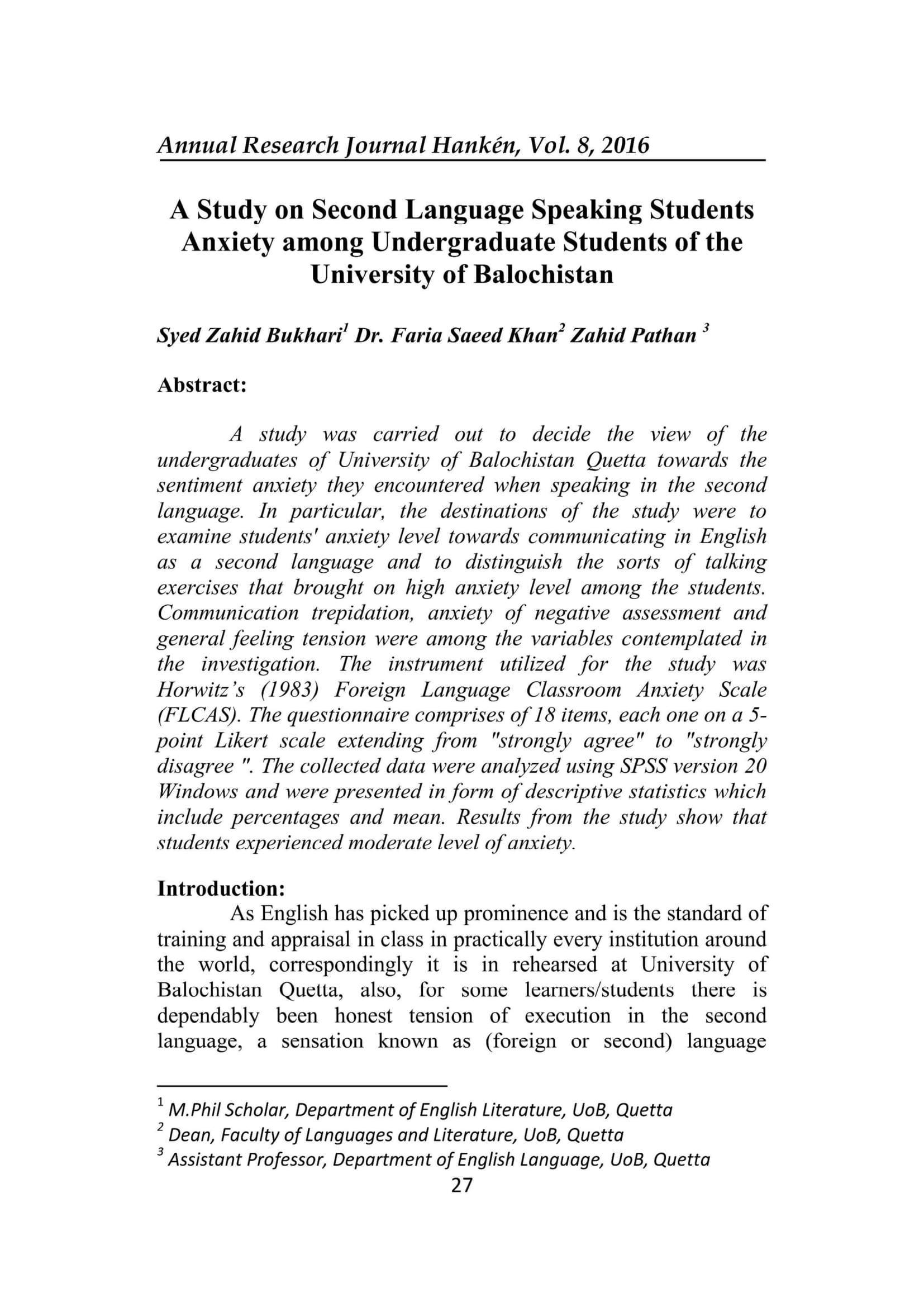A Study on Second Language Speaking Students Anxiety among Undergraduate Students of the University of Balochistan
Keywords:
institution, Balochistan, UniversityAbstract
A study was carried out to decide the view of the undergraduates of University of Balochistan Quetta towards the sentiment anxiety they encountered when speaking in the second language. In particular, the destinations of the study were to examine students' anxiety level towards communicating in English as a second language and to distinguish the sorts of talking exercises that brought on high anxiety level among the students. Communication trepidation, anxiety of negative assessment and general feeling tension were among the variables contemplated in the investigation. The instrument utilized for the study was Horwitz‟s (1983) Foreign Language Classroom Anxiety Scale (FLCAS). The questionnaire comprises of 18 items, each one on a 5-point Likert scale extending from "strongly agree" to "strongly disagree ". The collected data were analyzed using SPSS version 20 Windows and were presented in form of descriptive statistics which include percentages and mean. Results from the study show that students experienced moderate level of anxiety.
References
Baddeley, A. D. (1999). Essentials of Human Memory.UK: Hove England Psychology Press Ltd.
Blau, A. (1955). A unitary hypothesis of emotion: Anxiety, Emotions of Displeasure, and Affective Disorders, Psychoanalytic Quarterly, 24, 75 – 103.
Cassady, J. C. (2004). The impact of cognitive test anxiety on text comprehension and recall in the absence of external evaluative pressure. Applied Cognitive Psychology, 18, 311-325.
Horwitz, E. K., Horwitz, M. B., & Cope, J. A. (1986). Foreign language classroom anxiety. Modern Language Journal, 79 (1), 125-132.
Horwitz, E. K. & Young, D.J. (Eds.). (1991). Language anxiety: from theory and research to classroom implications. Englewood Cliffs, NJ: Prentice Hall.
Horwitz, E. K. (2001). Language anxiety and achievement. Annual Review of Applied Linguistics, 21, 112 – 126.
Horwitz, E. K., Horwitz, M. B., & Cope, J. (1986). Foreign language classroom anxiety. Modern Language Journal, 70 (2), 125 – 132.
Liebert, R. M., & Morris, L. W. (1967). Cognitive and emotional components of test anxiety: A distinction and some initial data. Psychological Reports, 20 (3), 975-978.
Lynne, H. (1984). The ESL noise test: cultural differences in affect and performance. Retrieved in September 2008 from ERIC Database (ED274171).
A Study on Second Language Speaking Students Anxiety among Undergraduate Students of the University of Balochistan
MacLeod, C. (1996). Anxiety and cognitive processes. In I. G. Sarason, G. R. Pierce, & B. R. Sarason (Eds.), Cognitive Interference-Theories, Methods and Findings (pp. 47-77). New Jersey, USA: Lawrence Erlbaum Associates Inc.
Madsen, H. S. & Murray, N. (1984). Retrospective evaluation of testing in ESL content and skills courses. Retrieved in September 2008 from ERIC Database (ED249815).
Mandelson, L. R. (1973). Test performance on verbal learning task as a function of anxiety-arousing testing instructions. Journal of Educational Research, 67
(1), 37 – 40.
Minor, S. W., & Gold, S. R. (1985). Worry and emotionality components of test anxiety. Journal of Personality Assessment, 49 (1), 82-85.
Oh, J. (1992). The effects of L‘ reading assessment methods on anxiety level. TESOL Quarterly, 26 (1), 172 – 176.
Scott, M. L. (1986). Student affective reactions to oral language tests. Language Testing, 3 (1), 99 – 118.
Scovel, T. (1978). The effect of affect on foreign language learning: A review of the anxiety research. Language Learning, 28, 129 – 42.
Shohamy, E. (1982). Affective considerations in language teaching.
Modern Language Journal, 66 (1), 13 – 17.
Spielberger, C. (1983). Manuel for the state-trait anxiety inventory. Palo Alto, Calif.: Consulting
Syed Zahid Bukhari et al
Spielberger, C. D. (1972b). Anxiety as an emotional state. In C. D. Spielberger (Ed.), Anxiety-Current Trends in Theory and Research (Vol. 1, pp. 23-49). New York, USA: Academic Press. ychologists Press.
Spielberger, C. D., & Vaag, P. R. (1995). Test anxiety:A transactional process model. In C. D. Spielberger, & P. R. Vaag (Eds.), Test Anxiety:Theory, Assessment and Treatment (pp. 1-14). Washington DC, USA: Taylor and Franchis.
Vasey, M. V., El-Hag, N., & Daleiden, E. L. (1996). Anxiety and the processing of emotionally threatening stimuli: Distinctive patterns of selective attention among high and low test anxious children. Child Development, 67 (3), 1173-1185.
Zeidner, M., & Matthews, G. (2005). Evaluation anxiety-Current theory and research. In A. J. Elliot, & C. S. Dweck (Eds.), Handbook of Competence and Motivation (pp. 141-163). New York: The Guilford Press.


